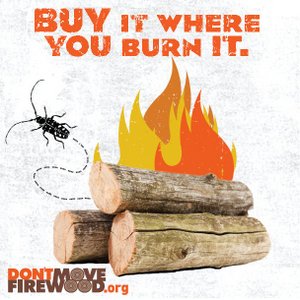Help us prevent the spread of invasive forest pests!
Moving firewood spreads insect pests and tree diseases that will kill trees in your community.
Dozens of emerald ash borer infestations have been found in or near campgrounds, including the first infestations in Missouri, Indiana and West Virginia. New Asian longhorned beetle infestations developed when firewood was transported from Brooklyn to eastern Long Island, within Clermont County in Ohio, and most likely from Worcester to Boston, MA.
Buy local firewood.
Vermont state campgrounds have local firewood available at each campground. There are pleny of convenient locations to buy local firewood throughout the state, just ask your campground host!
To help slow the spread of emerald ash borer within Vermont, ash firewood that has not been heat treated should not be moved outside of the Emerald Ash Borer Infested Area in Vermont.
Watch: Keep VT woods Beautiful & Healthy Video
Rule Governing the Importation of Untreated Firewood into the State of Vermont
A firewood rule went into effect May 1, 2016. Cut firewood cannot be brought into Vermont without a certification that it is heat treated.
More information about this rule can be found here.
Find out about other state quarantines here.
Read more at Don'tMoveFirewood.org
You Can Help
Here are some simple things you can do to stop the spread:
- Don't Move Firewood. Buy it where you burn it!
- Learn to recognize invasive forest pests and keep an eye out for them in your community.
- Report suspicious findings.
- Spread the word! Post educational materials and teach others about the law.
Have More Questions?
Click below to find out more information about transporting firewood.
Frequently Asked Questions
- What do you mean by “moving firewood”? Can I take it camping if I stay in Vermont?
-
Moving firewood refers to how far it travels between the tree it came from and where it is burned. In some cases, this means transportation to your home from a producer for home heating purposes. It also refers to packing firewood in your vehicle to take with you on a camping trip. Even if you’re moving firewood within Vermont, you can move pests from one part of the state to another. Get wood from the closest source possible. Anything over 50 miles is too far, and within 25 miles is better.
- I already moved firewood. How can I dispose of it properly?
-
The best option is to burn it quickly, completely, and safely. Rake up bark or other debris and burn them as well. Do not leave it on site or carry it to a new location.
- Can I safely move firewood that is air-dried?
-
Unfortunately, seasoning firewood – storing it cut and piled and letting it air-dry for a period of time – is not a proven way to eliminate potential invasive insects or diseases.
- What about scrap lumber?
-
Although the rule doesn’t apply to lumber, remember that any wood that isn’t heat treated could carry live insects or diseases. Don’t burn lumber that is pressure-treated with preservatives, because it will release toxic compounds. Painted wood, and products that contain glue, may release toxins as well.
- Where can I get firewood?
-
Most campgrounds will have firewood available or will be able to direct you to a local source. If the firewood wasn’t harvested nearby, make sure the bundle is labeled with a USDA seal or other certification that it was heat treated. Burn any unpackaged firewood at the campsite; don’t take any with you to your next destination.
- What does the certification label look like?
-
The label should say that the wood was heat treated at 160°F for at least 75 minutes. Wood that has a US Department of Agriculture label saying that it is certified under “all applicable” federal and state quarantines has been adequately heat treated. “Kiln dried” wood may not be.
- Can I take Vermont firewood camping out of state?
-
It is just as important for Vermonters not to move firewood to other states. There are non-native pests in Vermont that could be spread to new locations, such as hemlock woolly adeglid, Sirex woodwasp, and spongy moth. Find out about other state quarantines here.
Resources
Print and share the poster resources below (created 2023).
Impacts of invasive forest pests

